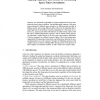Free Online Productivity Tools
i2Speak
i2Symbol
i2OCR
iTex2Img
iWeb2Print
iWeb2Shot
i2Type
iPdf2Split
iPdf2Merge
i2Bopomofo
i2Arabic
i2Style
i2Image
i2PDF
iLatex2Rtf
Sci2ools
94
Voted
ECCV
2006
Springer
2006
Springer
Aligning Sequences and Actions by Maximizing Space-Time Correlations
Abstract. We introduced an algorithm for sequence alignment, based on maximizing local space-time correlations. Our algorithm aligns sequences of the same action performed at different times and places by different people, possibly at different speeds, and wearing different clothes. Moreover, the algorithm offers a unified approach to the problem of sequence alignment for a wide range of scenarios (e.g., sequence pairs taken with stationary or jointly moving cameras, with the same or different photometric properties, with or without moving objects). Our algorithm is applied directly to the dense space-time intensity information of the two sequences (or to filtered versions of them). This is done without prior segmentation of foreground moving objects, and without prior detection of corresponding features across the sequences. Examples of challenging sequences with complex actions are shown, including ballet dancing, actions in the presence of other complex scene dynamics (clutter), as ...
Algorithm Aligns Sequences | Computer Vision | Dense Space-time Intensity | ECCV 2006 | Foreground Moving Objects | Multi-sensor Sequence Pairs | Sequence Alignment |
Related Content
| Added | 16 Oct 2009 |
| Updated | 16 Oct 2009 |
| Type | Conference |
| Year | 2006 |
| Where | ECCV |
| Authors | Yaron Ukrainitz, Michal Irani |
Comments (0)

